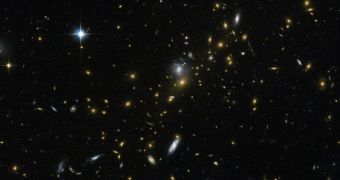Astronomers using the NASA/ESA Hubble Space Telescope were recently able to capture an amazing new view of the galaxy cluster MACS J0454.1-0300, which is located several billion light-years away from Earth. The object is so massive that it tips the scales at around 180 trillion solar masses, an early estimate reveals. Such structures can easily be used as gravitational lenses, astrophysicists say.
A gravitational lens is a large galaxy or galactic cluster that features so much mass that it distorts the light passing through and around it. In this manner, any radiation emitted by objects located behind the lens is amplified by the latter's gravitational pull. Astronomers have been using this technique for many years, primarily to study objects located extremely far away.
In the new Hubble image, for example, each dot you see is in fact a galaxy featuring millions to billions of stars. This should give you a sense of scale on the telescope's field and depth of view. It helps to put things into perspective if you think of our entire galaxy as just another one of these dots.
The elongated objects that look like sweeping arcs in the left-hand side of the image actually have normal shapes, but appear distorted due to the effects the MACS J0454.1-0300 cluster has on the light they emit. One of Hubble's science goals is to identify as many of these clusters as possible, so that they can be used to look for the earliest galaxies in the Universe.

 14 DAY TRIAL //
14 DAY TRIAL //